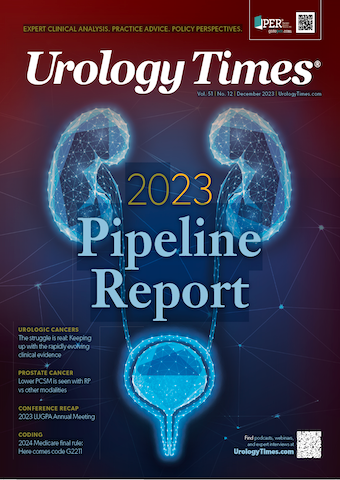Commentary
Article
Urology Times Journal
Study: Lower PCSM is seen with radical prostatectomy vs other modalities
Author(s):
"This large registry study with data from varied practice settings, incorporating the most commonly used treatment modalities, provides useful data on the long-term mortality outcomes," writes Badar M. Mian, MD.
Badar M. Mian, MD

For men with clinically localized prostate cancer, several treatment options are available, and the effectiveness of each option in terms of survival outcomes and quality of life are often debated. The treatment options with curative intent include radical prostatectomy (RP), externalbeamradiationtherapy (EBRT), brachytherapy(BT), and initialmonitoringwith active surveillance (AS). Other management strategies for cancer control with delayed intervention include watchfulwaiting (WW) and occasionally androgen deprivation therapy as primary monotherapy (PADT).
The selection of therapy often depends on patient factors (age and health), tumor factors (grade and stage), and patient or physician preference. Both randomized and observational studies have yielded mixed results about the comparative effectiveness of various treatment options. A recent study by Herlemann et al, based on the multicenter, prospective Cancer of the Prostate Strategic Urologic Research Endeavor (CaPSURE) registry, analyzed prostate cancer–specific mortality (PCSM) and all-cause mortality (ACM) after RP, BT, EBRT, PADT, or AS/WW.1
The CaPSURE registry includes clinical and patient-reported data for more than 15,000 patients from 45 largely community-based urology practices. Patients were treated according to the usual practices at participating sites. Data on outcomes, quality of life, and complications were reported by the participating clinicians. Patients were followed until withdrawal from the study or death. The University of California, San Francisco Cancer of the Prostate Risk Assessment (CAPRA) score (0 to 10) was used for risk stratification on the basis of prostate-specific antigen, Gleason score, clinical stage, and number or percent of positive biopsy cores and age. PCSM was defined as prostate cancer listed as a primary, secondary, or tertiary cause of death on the death certificate.
After excluding patients with metastatic or locally advanced disease, the study cohort consisted of 11,864 men who received primary treatment with RP, BT, EBRT, PADT, or AS/WW. Of these, 6227 men (53%) underwent RP, 1645 (14%) received BT, 1462 (12%) underwent EBRT, 1510 (13%) received PADT, and 1020 (9%) were managed with AS/WW. Baseline demographics and clinical characteristics of patients receiving different primary treatments varied significantly (P < .001). Men who underwent RP were generally younger with fewer comorbidities compared with patients undergoing other treatments. As expected, a higher proportion of men on AS/WW had a Gleason score of 6 at biopsy in comparison with other treatment groups.
Among patients undergoing RP, 5.4% received postprostatectomy radiation therapy at some point. Rates of neoadjuvant/adjuvant ADT were 66% for men undergoing EBRT and 59% for men undergoing BT for tumors with a CAPRA score of 6 to 10. Of the patients on AS/WW, 32.4% eventually received treatment. The median follow-up for men not dying from prostate cancer was 87 months, with 3849 patients surviving for at least 10 years and 1577 patients surviving for at least 15 years.
Of the 5793 deaths, 764 were related to prostate cancer. PCSM risk increased consistently with increasing CAPRA scores across all treatment modalities. After adjustment for the clinical CAPRA score, the HR for PCSM, when compared with RP, was 1.57 (95% CI, 1.24-1.98; P < .001); for BT, 1.55 (95% CI, 1.26-1.91; P < .001); for EBRT, 2.36 (95% CI, 1.94-2.87; P < .001) for PADT; and 1.76 (95% CI, 1.30-2.40; P < .001) for AS/WW. RP was associated with a lower risk of PCSM than all other treatments. The PCSM (adjusted for risk categories) with minimum 5-year follow-up also yielded increased PCSM risk, following BT, EBRT, and PADT in comparison with RP. Similarly, the estimated 20-yr PCSM risk (using statistical modeling) was higher in men treated with BT, EBRT, and PADT when compared with RP.
The HRs for ACM were calculated after adjustment for age, comorbidity, and clinical CAPRA score. The risk of ACM was higher in men treated with BT (1.39; 95% CI, 1.26-1.52), 1.32 (95% CI, 1.20-1.44) for EBRT, 1.79 (95% CI, 1.62-1.98) for PADT, and 1.50 (95% CI, 1.34-1.68) for AS/WW when compared with RP (P < .001). Competing risk analysis showed that all other treatment groups were associated with greater ACM in comparison with RP.
It is often stated that for men with localized prostate cancer, any of the commonly used treatment modalities should be equally effective. However, these results demonstrate superior survival outcomes following surgery, especially for clinically significant prostate cancer. In one of the largest randomized controlled trials to date comparing AS, RP, and EBRT, there were no differences in mortality rates among the 3 treatment modalities. Although there are other observational studies that have yielded similar results demonstrating lower PCSM after RP when compared with EBRT, the confounding effect of selection bias cannot be overlooked. There are other differences between studies and between cohorts within a study that can impact survival outcomes. For example, both the use of concurrent ADT with EBRT and the use of post-RP radiation therapy in this study were lower than expected, which could have an effect on cancer control and survival outcomes.
Another interesting finding from this study, which may seem somewhat contradictory at first glance, is that men who were initially with AS/WW had worse PCSM than those receiving RP or EBRT. Men with clinically localized prostate cancer are managed with AS or WW due to presence of certain factors such as older age, low-risk cancer, or comorbidities. These features make it unlikely for the patient to die from progressive disease especially since deferred treatment is often quite effective. Here, the cohort on AS/WW had worse mortality despite receiving deferred treatment with curative modalities. Why should that be the case?
A possible explanation is that the AS/WW protocols then (in the 1990s) vs now look very different due to changes in selection criteria, and advances in the diagnostic and therapeutic landscape. The AS/WW cohort in this study likely had under sampling and understaging of higher risk cancer, thus resulting in undertreatment. As mentioned earlier and acknowledged by the authors, despite carefully controlling for factors confounding related to patient factors, physician factors and selection criteria can still exist in observational studies.
This large registry study with data from varied practice settings, incorporating the most commonly used treatment modalities, provides useful data on the long-term mortality outcomes. These survival outcomes can facilitate shared decision-making about the management of localized prostate cancer when considered in conjunction with patient priorities about both the quantity and quality of life.
Reference
1. Herlemann A, Cowan JE, Washington SL III, et al. Long-term prostate cancer–specific mortality after prostatectomy, brachytherapy, external beam radiation therapy, hormonal therapy, or monitoring for localized prostate cancer. Eur Urol. 2023;S0302-2838(23)03155-X. doi:10.1016/j.eururo.2023.09.024

Newsletter
Stay current with the latest urology news and practice-changing insights — sign up now for the essential updates every urologist needs.


























